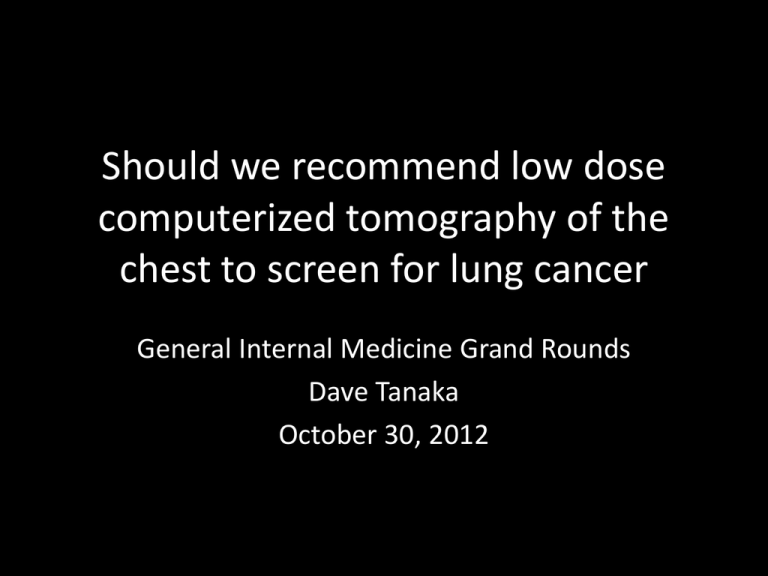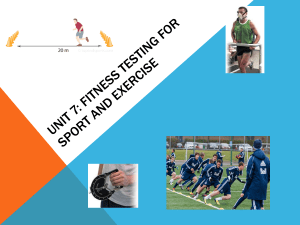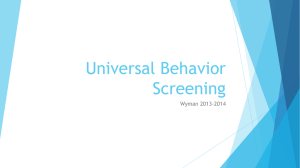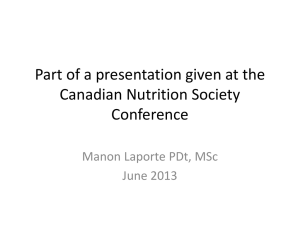
Should we recommend low dose
computerized tomography of the
chest to screen for lung cancer
General Internal Medicine Grand Rounds
Dave Tanaka
October 30, 2012
Objectives
• Review previous data on lung cancer screening
• Review the National Lung Screening Trial
• Review current recommendations for lung
cancer screening
• Each clinician should have “Talking points” for
patient discussions
Lung Cancer Facts
• Lung cancer is the leading cause of cancer
death in US (worldwide)
• The American Cancer society estimates that
there will be 226,160 new cases of lung cancer
and 160,340 deaths in US is 2012
• Most lung cancer is diagnosed at advanced
stage (40% stage IV, 30% III)
• 5 year survival 16%
Questions
• How many have had patients request lung
cancer screening?
• How many have offered chest xrays as lung
cancer screening?
• How many have offered chest CT scanning for
lung cancer screening?
Lung Cancer screening practices of primary care
physicians: results form a national survey
• 2006-2007 national survey, 962 responses, 38%
no lung cancer screening, 55% had ordered CXR,
22% LDCT and <5% cytology
• 25% believed an expert group recommends lung
cancer screening
• The factors that predict ordering of lung cancer
screening: belief that experts recommend it or
that screening tests are effective, if they would
recommend screening for asymptomatic, nonsmokers and if their patients had asked them
about screening.
Chest xrays
• 4 RTC 6,300-11,000 patients, 1970-1980’s
• No difference in lung cancer mortality in the
screening groups vs controls (this compared
more frequent CXR’s because CXR was often
used on regular basis for smokers)
• There were increased numbers of lung cancers
found in the screened group (over diagnosis)
PLCO study
• RTC 154,901 1993-2001 age 55-74
• CXR at baseline then 3 annual screens vs usual
care
• F/U to max 13 years
• 10% current smokers, 42% previous smokers,
11% with 1st degree relative with lung cancer
• CXR screened lung cancer mortality 0.99
(0.87-1.22) vs usual care
PLCO study (NLST eligible)
•
•
•
•
CXR 15,183 vs usual care 15,138
CXR 60.9% male vs usual care 60.2%
CXR 52.0 pack yrs vs usual care 52.5 pack yrs
Lung cancer incidence (per 100,000 personyrs) CXR 606 vs usual care 608 (RR 1.00 0.881.13)
• Lung cancer mortality CXR 361 vs usual care
383 (RR 0.94 0.81-1.10)
PLCO study conclusions
• No benefit from CXR screening in lung cancer
mortality vs usual care
• Subanalysis (NLST eligible) – no benefit from
CXR screening in lung cancer mortality at 6
years (no difference at 13 years)
National Lung Screening Trial
• RTC 53,434 8/2002-4/2004 33 US MedCen
• Age 55-74, smoked > 30 pack-yrs, quit within
past 15 years
• Exclusions: previous diagnosis of lung cancer,
hemoptysis or unexplained weight loss > 6.8
kg (15 lbs) in preceding year
NLST
• Randomized to LDCT scan (26,722) vs CXR
(26,732)
• 3 screening studies, T0, T1, T2 done at 1 year
intervals
• Positive result defined as > 4mm non-calcified
nodule
Results
T0
T1
T2
Total
Positive
False
Positive
CT scan
27.3%
27.9%
16.8%
39.1%
96.4%
CXR
9.2%
6.2%
5.0%
16.0%
94.5%
Adverse Events
Complications after diagnostic evaluation
procedure after positive screening test
CT scan 1.4%
CXR
1.6%
Major complications after diagnostic evaluation
CT scan lung cancer +11.2%
- 0.06%
CXR
lung cancer + 8.2%
- 0.02%
Lung Cancer
• CT scan 1060
• CXR
941
645 / 100,000
572 / 100,000
Lung Cancer Mortality
CT scan
CXR
356
443
247 / 100,000
309 / 100,000
1.4%
1.7%
Absolute difference of 0.3%
For every 1,000 screened there will be 14 lung
cancer deaths after 3 yearly CT scans and total
time of 6.5 years, 3 lung cancer deaths will be
averted.
The Role of Computed
Tomography (CT) Screening
for Lung Cancer
Recommendations from the American College of Chest
Physicians and the American Society of Clinical
Oncology
RECOMMENDATIONS
Note: Grade of recommendations based on modified
GRADE approach (http://www.gradeworkinggroup.org)
Recommendation 1
• For smokers and former smokers who are age 55
to 74 and who have smoked for 30 pack years or
more and either continue to smoke or have quit
within the past 15 years, we suggest that annual
screening with low-dose CT should be offered
over both annual screening with chest radiograph
or no screening, but only in settings that can
deliver the comprehensive care provided to NLST
participants.
• Grade of recommendation: 2B
•
Note: Pack year = the number of packs of cigarettes smoked per day multiplied by the
number of years a person has smoked
Remarks for Recommendation
1
• Remark 1: Counseling should include a complete
description of potential benefits and harms, as outlined
the guideline (online), so the individual can decide
whether or not to undergo LDCT screening.
• Remark 2: Screening should be conducted in a center
similar to those where the NLST was conducted, with
multi-disciplinary coordinated care and a comprehensive
process for screening, image interpretation,
management of findings, and evaluation and treatment
of potential cancers.
Continued on next slide
Remarks for Recommendation 1, cont’d
• Remark 3: A number of important questions about screening
could be addressed if individuals who are screened for lung
cancer are entered into a registry that captures data on
follow-up testing, radiation exposure, patient experience, and
smoking behavior.
• Remark 4: Quality metrics should be developed such as those
in use for mammography screening, which could help
enhance the benefits and minimize the harm for individuals
who undergo screening.
Continued on next slide
Remarks for Recommendation 1, cont’d
• Remark 5: Screening for lung cancer is not
a substitute for stopping smoking. The
most important thing patients can do to
prevent lung cancer is not smoke.
• Remark 6: The most effective duration or
frequency of screening is not known.
Recommendation 2
• For individuals who have accumulated fewer
than 30 pack years of smoking or are either
younger than age 55 or older than 74, or
individuals who quit smoking more than 15
years ago, and for individuals with severe
comorbidities that would preclude potentially
curative treatment and/or limit life
expectancy, we suggest that CT screening
should not be performed.
• Grade of recommendation: 2C
Clinician-Patient Communication
•
•
•
•
Quantify the potential benefits
Quantify the potential harms
Emphasize smoking cessation
Point to useful tools on smoking cessation,
risk of radiation exposure and calculating
lung cancer risk
Future Directions/Research
Outstanding questions/suggested research
• Generalizability of reported findings
• Comparison of limited # of annual screenings to
potentially higher # of annual screenings
• Optimum screening schedule
• Cost-effectiveness studies
• Randomized trials with participants of different
ages and smoking histories than in the NLST and
in settings unlike those in previous studies
How NLST might apply to a patient
• Estimates are based on 2 models, one that
predicts the chance of dying from lung cancer
in a year and the other that predicts the
chance of dying from other causes in a year.
• The models considered the person’s age, sex,
smoking history and exposure to asbsetos.
Both models have been studied the lung
cancer (validated) and other (under predicted)
Average NLST patient
• 62 yo male current smoker, 1.5 ppd for 35 years
• Deaths from lung cancer (without screening) per
1000 person
19.5
• Deaths from lung cancer (with screening) per
1000 persons
15.6
• Deaths averted per 1000 3.9
• Persons needed to be screened for 3 y to prevent
1 death from lung cancer over 6 years - 256
Min eligible NLST participant
• 55 yo female former smoker 1 ppd for 30 years,
who just quit
• Deaths from lung cancer (without screening) per
1000 person
4.0
• Deaths from lung cancer (with screening) per
1000 persons
3.2
• Deaths averted per 1000 0.8
• Persons needed to be screened for 3 y to prevent
1 death from lung cancer over 6 years - 1236
High-risk NLST participant
• 70 yo current 2 ppd smoker for 55 years
• Deaths from lung cancer (without screening)
per 1000 person
60.9
• Deaths from lung cancer (with screening) per
1000 persons
48.7
• Deaths averted per 1000
12.2
• Persons needed to be screened for 3 y to
prevent 1 death from lung cancer over 6 years
- 82
Min eligible participant by NCCN
guidelines
• 50 yo male former smoker 1 ppd for 20 years,
who quit 10 years ago with an occupational
asbestos exposure history
• Deaths from lung cancer (without screening) per
1000 person
1.6
• Deaths from lung cancer (with screening) per
1000 persons
1.3
• Deaths averted per 1000 0.3
• Persons needed to be screened for 3 y to prevent
1 death from lung cancer over 6 years - 3180
Low risk eligible participant for
Sequoia Hospital lung screening
• 40 yo female former smoker 1 ppd for 10 years,
who quit 15 years ago
• Deaths from lung cancer (without screening) per
1000 person
0.10
• Deaths from lung cancer (with screening) per
1000 persons
0.08
• Deaths averted per 1000 0.02
• Persons needed to be screened for 3 y to prevent
1 death from lung cancer over 6 years - 35186
Harms of LDCT for lung cancer
screening
• Detection of abnormalities
• In review of RTC and cohort studies the
average detection of lung nodules was 20%
• More than 90% were false positives
• In NLST, 1.2% of patients not found to have
lung cancer underwent invasive procedure
and 0.7% had thoracoscopy, mediatinoscopy
or thoracotomy
Adverse Events
Complications after diagnostic evaluation
procedure after positive screening test
CT scan 1.4%
CXR
1.6%
Major complications after diagnostic evaluation
CT scan lung cancer +11.2%
- 0.06%
CXR
lung cancer + 8.2%
- 0.02%
Harms of LDCT for lung cancer
screening
Overdiagnosis
• Previous studies suggest that CXR may have an
overdiagnosis rate of 25%
• NLST show 120 excess lung cancers in the CT
scan group vs CXR but further f/u is necessary
Harms of LDCT for lung cancer
screening
• Radiation exposure
• LDCT 1.5 mSv per exam
• Diagnostic chest CT 8 mSv, Chest CT/PET 14
mSv
• Average NLST patient received 8 mSv over 3
years (screens (3) + diagnostic) and it is
estimated that will cause 1 death from cancer
per 2500 persons screened
Harms of LDCT for lung cancer
screening
• Quality of Life
• CT scan screening 88-91% reported on discomfort
but 46% reported psychological distress while
awaiting the results
• There may be QOL benefits from lower morbidity
from advanced lung cancer but there are also
potential harms due to anxiety, cost and harms
from diagnostic tests for false positive scans and
overdiagnosed cancers
Other considerations
• The operative mortality for lung cancer
surgery in NLST was 1% in CT scan and 0.2% in
CXR. This compares to 4% operative mortality
seen in general population study.
• Cost effective analysis is planned and is
pending
Other considerations
• Will populations with a different risk profile
than NLST benefit?
• Are less frequent screening regimens
effective?
• How long should screening continue?
• Would a different criteria for a positive scan
provide the same benefit but at less risk of
false positive / lower cost?
Conclusions
• There is no benefit from CXR screening for
lung cancer
• The NLST demonstrates a lung cancer
mortality benefit with 3 yearly LDCT scans and
an average f/u of 6.5 years. The absolute
benefit is 0.3% or 1 averted death / 320
screened
• The average rate of positive scans is 20%
(90+% are false positives)
Conclusions
• The risk of major complication seen in NLST
for patients not diagnosed with lung cancer
undergoing diagnostic procedure is 0.06%
• The risk from radiation estimated for the
average NLST participant (8mSv) is 1 cancer
death per 2500 participants
My recommendation
• If after discussion of risks and benefits, I
would only offer LDCT screening for
individuals that meet the NLST eligibility
criteria – age 55-74, smoking at least 30 packyears, quit within previous 15 years. I would
recommend LDCT for no more than 3 years.
Introduction & Context
• High mortality associated with lung cancer
• Most diagnoses occur at later stages
• Prior to screening with low-dose computed
tomography (LDCT), no evidence that screening
strategies decreased lung cancer mortality risk
• National Lung Screening Trial (NLST) – first
randomized controlled trial (RCT) to show a
screening benefit in people with a history of heavy
smoking (e.g. smoking 1 pack a day for 30 years
or 2 packs a day for 15 years)
• All screening technologies carry potential benefits
and potential harms
Guideline Methodology: Systematic
Review
• Guideline based on a systematic review by the
American Cancer Society, American College of Chest
Physicians, American Society for Clinical Oncology
and National Comprehensive Cancer Network
• An Expert Panel reviewed relevant medical literature
• Databases searched and data parameters
MEDLINE: 1996-April 2012
EMBASE: 1996-April 2012
Cochrane Collaboration Library: April 2012
Evidence base: Eight RCTs and thirteen cohort studies
in which all subjects were screened with LDCT
Clinical Questions
• Key Question 1: What are the potential
benefits of screening individuals at elevated
risk of developing lung cancer using LDCT?
• Key Question 2: What are the potential harms
of screening individuals at elevated risk of
developing lung cancer using LDCT?
• Key Question 3: Which groups are most likely
to benefit or not benefit from screening?
• Key Question 4: In what setting is screening
likely to be effective?
Abbreviations: LDCT, low-dose computed tomography
Summary of the Evidence
1. The National Lung Screening Trial (NLST), a
large, high quality randomized controlled study
demonstrated that among adults between the
ages of 55-74 who smoked at least 30 pack
years, including former smokers who quit within
15 years, annual screening with low-dose CT
for 3 consecutive years reduced the absolute
risk of lung cancer death by 0.33% when
compared to annual screening with chest
radiography. (continued on next slide)
Summary of the Evidence, cont’d
1 (cont’d). This translates to 3 fewer deaths
from lung cancer for every 1,000 high-risk
individuals who undergo CT screening rather
than screening with chest radiography and a
20% relative risk reduction. This mortality
reduction was observed over a median
follow up of 78 months. Another smaller
randomized controlled trial of CT screening
did not find a benefit when compared with
no screening.
Summary of the Evidence, cont’d
2. Multiple studies have shown that screening
with low-dose CT finds lung nodules in about
180 of every 1,000 individuals who undergo
screening. While 95% of these nodules
ultimately prove not to be cancerous, their
evaluation typically involves repeat CT
scanning, and sometimes requires the use of
invasive procedures, including surgery.
Invasive procedures carry risks, including
rarely, major complications and even death.
Summary of the Evidence, cont’d
3. The reported outcomes for CT screening
have been achieved in selected, high-risk,
motivated study volunteers who underwent
screening at centers with experience in
imaging, diagnosis and treatment, using an
organized process of scanning, scan
interpretation and nodule evaluation.
Application of CT screening to lower risk
groups or outside of these settings may alter
the balance of observed benefits and harms
unfavorably.
Summary of the Evidence, cont’d
4. The reported benefit of CT screening is
primarily from a study that compared LDCT
screening to chest x-ray screening rather than
no screening. Studies have not found a benefit
of chest x-ray screening.
5. Extrapolated estimates suggest that the
magnitude of the harm from radiation delivered
by low-dose CT screening is smaller than the
estimated benefit of screening individuals such
as those screened in the NLST for lung cancer.






